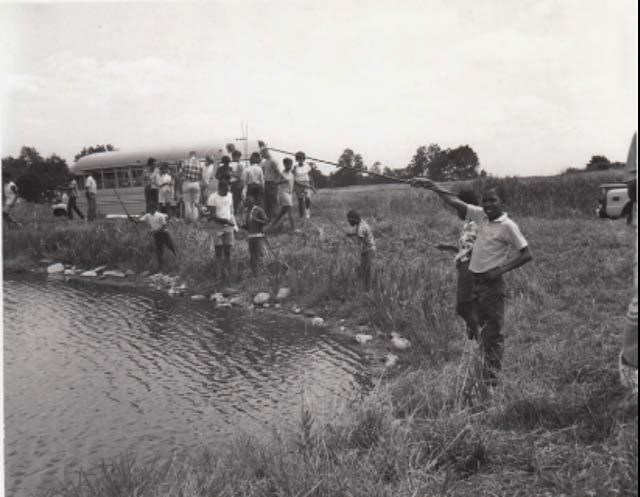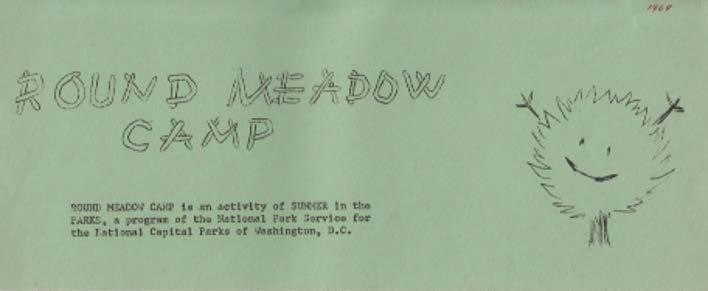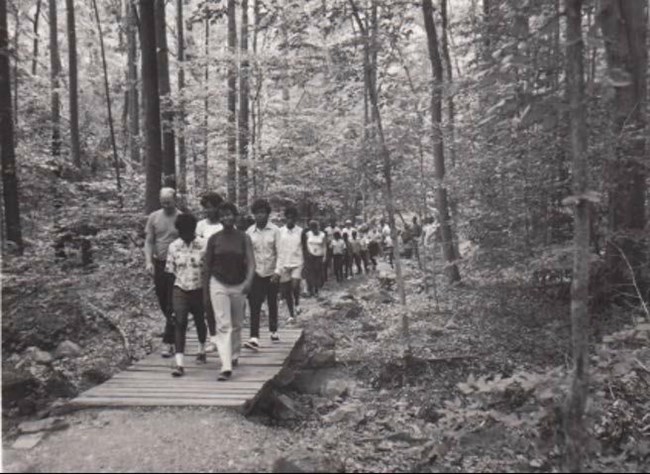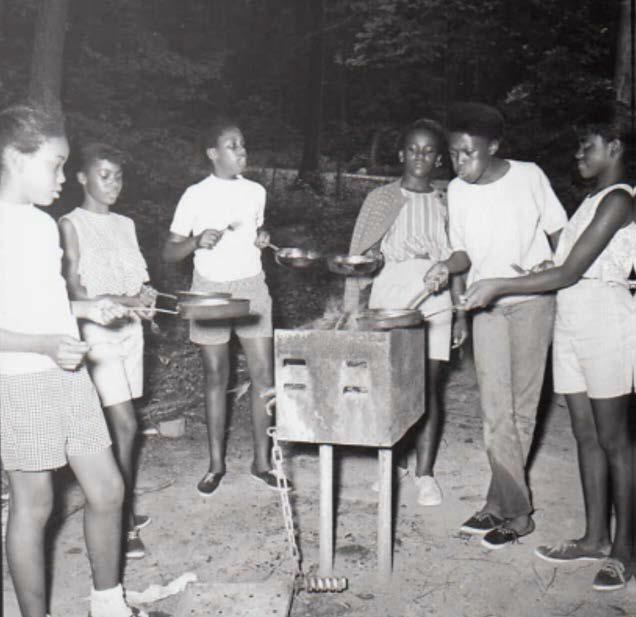Last updated: August 8, 2023
Article
African American Community Engagement in the 1960s: Summer in the Parks and the DC Environmental Outdoor Laboratory at Camp Round Meadow
Content excerpted from: Elder-Norquist E. 2020. Catoctin Mountain Park Administrative History Update. Organization of American Historians for National Park Service.
From the late 1960s to the early 1970s, Catoctin Mountain Park managed two programs that provided African American youths from the Washington, D.C. metro area with opportunities for outdoor recreation and education through the Summer in the Parks program (1968–1976) and the DC Environmental Outdoor Laboratory (1970–1975).

NPS
Overview
Before the assassination of Rev. Martin Luther King, Jr. and the subsequent April 1968 riots, National Park Service (NPS) Director George B. Hartzog unveiled his plans for a program called Summer in the Parks. This program was influenced by a similar program created by industrial designer Russel Wright in New York City’s Central Park, and it would feature surprise field trips to the outlying parks around Catoctin Mountain Park as well as events and activities such as musical performances, sporting events, and crafting activities in the National Capital Area Parks system.
After the April 1968 riots, the program received higher priority as federal officials saw its potential to help ease racial tension in Washington, D.C. As an even greater benefit, they saw the program’s potential to reach African American communities as it incorporated inclusive programs such as cultural performances.

NPS
Summer in the Parks at Catoctin Mountain Park

NPS
The Summer in the Parks program did not reach Catoctin Mountain Park until July 1969, six weeks after the Job Corps members vacated the camp at Round Meadow. Sixty children from Washington, D.C., both boys and girls, were bused to the Park for weeklong trips that included camping, fishing, hiking, and swimming. The program, referred to as Round Meadow Camp, was a success and continued throughout August and weekends in September.
In 1970, Catoctin received $75,000 to run a three-week cultural arts camp staffed by music and dance professionals with an education background. The cultural camp held three sessions, each lasting three weeks, and all sessions had about sixty children in attendance.
Summer in the Parks camp counselors at Catoctin later recounted that some children were scared to be in the woods for the first few nights. Another child was quoted in the Washington Post as saying “No pollution! No pollution whatsoever! The air looks fresh!”
The DC Environmental Outdoor Laboratory

NPS
The Summer in the Parks program overlapped with the DC Public School System’s Environmental Outdoor Laboratory, which was in its pilot phase in 1970. The idea for the Environmental Outdoor Laboratory was conceived in 1968 by Marguerite Selden, Assistant Superintendent of the Department of Summer Schools, Continuing Education and the Urban Service Corps. Selden, however, did not have a relationship with the NPS nor did she have the funds needed to start the program. Mrs. Alan Kirk, the wife of a special assistant to Secretary of the Interior Walter Hickel (Jan. 1969–Nov. 1970), was a volunteer with the Urban Service Corps and facilitated federal-local cooperation.
By the summer of 1970, the DC Public School System had permission to host its pilot Environmental Outdoor Laboratory program at Round Meadow. The DC Public School System was responsible for teaching while the NPS provided transportation and recreation. A total of 320 4th through 6th grade students participated in the program in 1970. Eighty students participated in each two-week session and were divided into groups of twenty. These groups spent half their day in study and the other half participating in outdoor activities. Since Round Meadow Camp and its Summer in the Parks program was operating simultaneously, the two groups were often integrated during campfire programs and mealtimes.
In regard to the curriculum of the Environmental Outdoor Laboratory, the basic reading material was “We are Black,” a series of ability-grouped short stories written by and about African Americans. Ecology was also studied through the NPS’s Project NEED (National Environmental Education Development), which was loosely structured and was aimed at increasing children’s understanding of and appreciation for the natural environment.
Outcomes

NPS
In the year of 1971, the Environmental Outdoor Laboratory operated for thirteen consecutive weeks (January 31st through May 28th) at Round Meadow. The DC Public School System’s Department of Science provided curriculum writers and staff while the NPS offered the services of a park ranger.
Approximately one hundred 5th grade students participated in the program per week. In 1973, funding for a thirty-six-week program was obtained through the Emergency School Aid Act (1972), which allowed the US Office of Education to allocate funds to school districts that were working to overcome segregation or reduce minority group isolation.
Data provided by the Division of Research and Evaluation, a division of the DC public school system, indicated that 6th graders would benefit most from the program. Therefore, in 1973, the Environmental Outdoor Laboratory became an annual program for 6th grade students. It is unclear if the Summer in the Parks program, which continued every year until 1976 in other National Capital Area parks, continued to operate at Catoctin.
Present-Day Programs
While these historic programs are no longer in operation, the park continues to offer recreational and educational experiences for kids and students, including the Junior Ranger Program, the Kids in Parks TRACK Trail program, and the Annual 4th Grade Pass as part of the Every Kid Outdoors program. The park also hosts all 5th and 6th graders from Frederick County Public Schools through their "Outdoor School" program as well as over 1,000 4th graders for plant and animal biology-focused field trips.
Read More About Catoctin
Learn more about African American history and influence at Catoctin Mountain Park and watch a 10-minute video entitled “Catoctin’s African American Legacy: The Iron Furnace.”
Also, another article based on excerpts from the 2020 Catoctin Mountain Park Administrative History Update tells the story of The Youth Conservation Corps at Catoctin Mountain Park.
